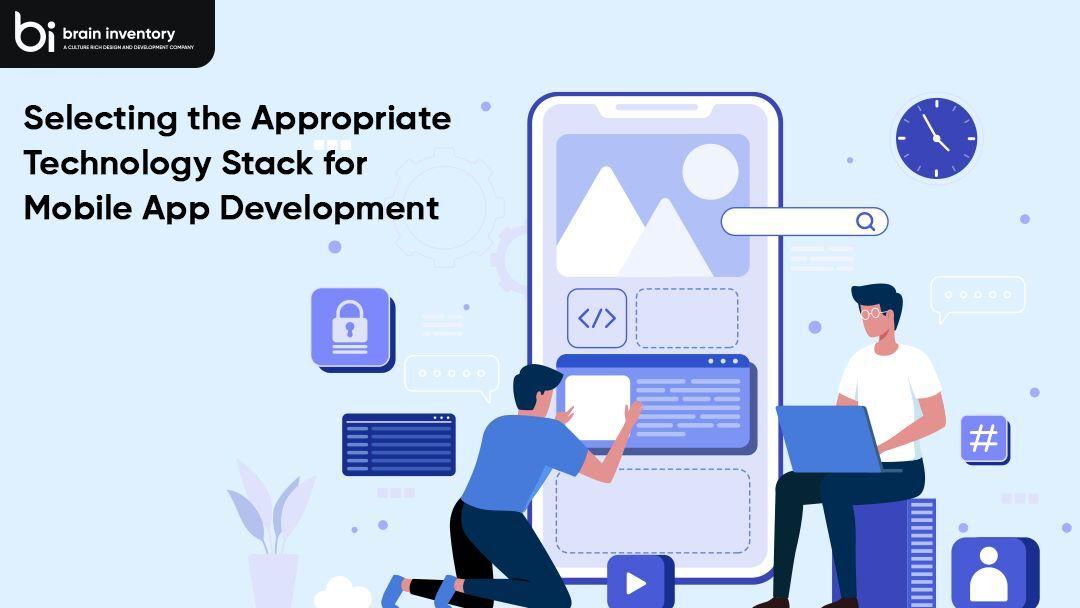Selecting the Appropriate Technology Stack for Mobile App Development

Quick Summary: Picking suitable technology for building mobile apps is vital for your project to thrive. The technology stack for mobile development includes programming languages, frameworks, and instruments. Deciding on the right stack relies on many elements, like project needs, intended users, finances, deadlines, and your developers’ skills. You must weigh all these aspects to determine the optimal technology mix that will empower your app and team to succeed. Though it takes effort to evaluate all options, choosing the right building blocks sets up your mobile initiative for achievement.
Introduction
In this blog post, we will explore the significance of selecting the appropriate technology stack for software development, whether it be for a web application or a mobile application. Later on, we will delve into the process of selecting the suitable technology stack for mobile app development.
As a leading company specializing in mobile app development, we place great emphasis on the selection of the optimal technology stack for creating mobile apps that possess exceptional performance, security, and scalability. The identification of the right technology stack is a fundamental aspect of our comprehensive range of mobile app development services.
What is a Technology Stack in Software App Development?
The technology stack of an application is organized into layers, with each layer representing a different component or technology that enables the application to be built and run. The stack has a layered architecture regardless of whether it is for an iOS or Android app. Three core layers make up any application’s technology stack:
Presentation layer or front-end: The front-end layer is in charge of the graphical interface and overall experience for the user when utilizing the application. It consists of technologies like HTML, CSS, JavaScript, and various front-end frameworks such as React, Angular, or Vue.js. The responsibility of the front-end layer is to render the application in the user’s web browser or mobile device and process user interactions. While presenting the information to the user, this layer handles the look, feel, and flow of the application.
Application layer or back-end: The back-end layer is where the application’s logic and core business functions reside. It utilizes server-side programming languages such as Java, Python, Ruby, or Node.js. To simplify development and provide reusable components, back-end frameworks and libraries like Django, Ruby on Rails, Express.js, or Flask are frequently leveraged. This layer is responsible for data processing, database interactions, server-side validation, and integration with different services and APIs. The goal is to perform the key server-side operations while abstracting away unnecessary complexity.
Data layer or database: The data layer in a technology stack is responsible for the management and storage of application data. This includes using database management systems (DBMS) like MySQL, PostgreSQL, MongoDB, or Oracle to model, store, retrieve, and manipulate data. It also handles ensuring data security, integrity, and ability to scale.
In addition to the presentation, logic, and data layers, a technology stack can incorporate extra components as needed for the application such as caching, message queuing, containerization, cloud services, and more. The key is that the data layer focuses on the storage and management of the data the application relies on.
Why Deciding a Technology Stack is Important in Software Development?
Choosing the right set of technologies to build a custom mobile app development is vital from the outset for several important reasons. The technology stack, meaning the programming languages, frameworks, libraries and developer tools used to construct an app, must be wisely selected upfront when embarking on mobile app development. Making well-informed decisions about which technologies to use early in the process can have a major effect on whether or not the app development project succeeds.
A few factors that highlight the necessity of deciding on technologies early on are:
Efficient Resource Allocation: Deciding on a technology stack ahead of time enables the effective distribution of development resources. Each technology stack comes with its own set of demands in terms of developer expertise, abilities, and background. By selecting the technology stack in advance, project managers can guarantee that they have the appropriate team members with the necessary skills. This eliminates the necessity for time-consuming and expensive retraining or the recruitment of new developers halfway through the project.
Compatibility and Integration: When it comes to mobile apps, it is common for them to require integration with different third-party services, APIs, or existing systems. The level of compatibility and integration capabilities can vary depending on the technology stack being used. By deciding on the technology stack beforehand, developers can guarantee that the chosen stack can smoothly integrate with the necessary components. This minimizes the likelihood of facing compatibility problems down the line, which could result in project delays and the need for additional development efforts.
Performance and User Experience: The specific technologies used to build a mobile app significantly influence how well it performs and how good the user experience is. Certain technology combinations are more suitable for mobile and can enable better speed, responsiveness, and smoothness. If developers thoroughly evaluate technology options upfront, they can select frameworks and tools with a proven track record of exceptional performance. This allows them to create a seamless, fluid user experience. The goal is to rephrase the original text in a new way while conveying the same overall meaning.
Time and Cost Efficiency: Making wise choices regarding the set of technologies used can greatly influence how long it takes to build something and how much it costs. Every combination of technologies has its learning process, pace of creation, and accessible materials. By picking technologies that the developers already grasp or that have thorough documentation and community assistance, the development work can be sped up. This results in shorter cycles of creation, lower expenses, and a quicker launch of the product to the market.
Scalability and Future-proofing: When creating mobile apps, it is wise to think ahead about how the app may need to grow and adapt over time. The choices made regarding the technology stack and architecture should facilitate scalability, giving the app room to expand its capabilities and user base without major reworking. Opting for technologies and designs that allow for horizontal and vertical scaling enables the app to take advantage of more resources like storage, bandwidth, and computing power. Building in scalability makes the app resilient against future needs like larger user loads, additional features, or changes in user behavior. By planning for growth from the outset, developers can avoid having to fully rebuild or re-platform the app down the road as demands increase and the app evolves. Thinking long-term and designing for scalability now will pay dividends later.
Steps to Choose the Right Technology Stack for Mobile App Development
Define your project requirements: Begin by establishing a clear understanding of the objectives and prerequisites for your mobile application. Take into account the app’s intended use, characteristics, capabilities, ability to grow, level of protection, and performance requirements. Assess whether a native, hybrid, or cross-platform application is necessary.
Research available options: Mobile apps can be created using a variety of technical approaches. Developers have several programming languages and tools to build apps that run on iOS and Android operating systems. Native mobile development utilizes the native languages of the platforms, such as Swift for Apple devices and Java or Kotlin for Android gadgets. Hybrid frameworks like React Native and Flutter allow you to build apps using web technologies that work on both platforms. Cross-platform tools like Xamarin and PhoneGap take a single codebase and compile it to run on multiple mobile operating systems. Each methodology has advantages and disadvantages in factors such as functionality, community resources, speed, and device compatibility. Analyze the options thoroughly to determine what will work best for your needs.
Consider the target audience: When crafting an application, first determine who your intended users are and tailor it to their needs. If you are building an app for a particular platform or device, it may be optimal to develop a specialized version optimized for that system to provide the smoothest experience. Conversely, if you have a more expansive target market or limited means, a cross-functional or hybrid version that works across multiple platforms could prove more budget-friendly. The key is aligning your development approach with your audience and resources.
Evaluate development expertise: Evaluate the talents and knowledge of the programmers working on your project. If your programmers have a proven track record with certain technologies, it may be prudent to utilize their experience. Notwithstanding, if your programmers are eager to acquire new skills, explore choices that match their capacity and desire to improve.
Check third-party integrations: Assess if your application needs to connect with external third-party services, like payment processors, social networks, or data analysis platforms. Make sure the technology framework you select enables straightforward integration with the necessary services through application programming interfaces or software development kits.
Conclusion
When creating mobile applications, keep in mind that choosing the right technology stack is very important, but there is no single solution that works for every app. Each project has its own unique needs, so take into account the various factors discussed above and select a technology stack that matches the specific objectives, necessities, and limitations of your project.
If you have an innovative concept but are stranded with no means to implement it due to a lack of technical skills, you have come to the ideal solution.
Brain Inventory has established itself as the premier mobile application development company by providing comprehensive services ranging from expert consultation to development and beyond. We immerse ourselves in projects from the outset by providing a COMPLIMENTARY technical consultation where we identify all viable options and features that could satisfy your mobile app needs and business objectives, as well as the demands of your end users.
Share the details of your project now to schedule a call or receive a quick estimate. You can also recruit mobile app developers who will work closely with you from the very beginning.

Have an idea?
Get in touch, we’d be
happy to hear from you
We are always looking out for new collaborations, whether you are a client who is passionate about a project or a talent who is interested in joining our team, our doors are always open.
locate us

India (HQ)
618, Shekhar Central, Palasia Square, A.B Road, Indore, Madhya Pradesh, 452001
+918109561401

United Kingdom
Brain Inventory, SBVS, 8 Roundhay Road, Leeds, UK, LS7 1AB
+18008209286

Canada
44 Main Street East Milton, ONCanada L9T 1N3
+4166696505

Jordan
185 Wasfi Al-Tal Street, Ammon Oasis Complex P.O Box 4724 Amman 11953 Jordan
+960770781000

USA
720 Seneca St Ste 107 Seattle, USA 98101
+1(206)6533419
if it's digital,we'll make it.
- Numetric - Online Accounting Software similar to QuickBooks
- Bloomia - Kegel exercise
- Virifi - Blockchain Powered Document Certification & Signing Platform
- Revolution Travel CRM - Custom CRM Built for Travel Agents
- Fatoura - Online Invoicing Platform
- My Fit Mantra - Your health partner
- Ocureel - Relation Building and video sharing Application